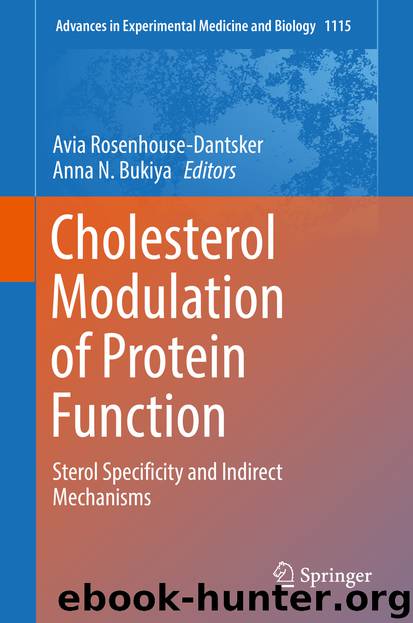Cholesterol Modulation of Protein Function by Avia Rosenhouse-Dantsker & Anna N. Bukiya

Author:Avia Rosenhouse-Dantsker & Anna N. Bukiya
Language: eng
Format: epub
ISBN: 9783030042783
Publisher: Springer International Publishing
Many of the molecular species of lipids and proteins in membranes do not mix ideally [19, 20, 41–47]—cholesterol is one such component that is unequally distributed in cellular membranes, allowing for the presence of liquid-ordered raft-like domains [19, 20, 32, 42, 46–52]. Such raft-like domains have attracted considerable attention as platforms for signaling regulation in cellular biology and pharmacology [53–60]. The concept that biomembranes are homogeneous two-dimensional fluids with randomly distributed proteins (the fluid mosaic model ) is challenged by the hypothesis that cellular membranes may contain such areas of lateral segregation [20, 55, 61–73]. By analysis of the liquid-ordered (l o) phase [74, 75] and its possible connection with rafts in biological membranes [76, 77], the effect of cholesterol on domain formation in liquid-crystalline bilayers has been of great interest for membrane biophysicists [78]. For instance, raft-like domains are believed to occur in lipid systems with coexisting liquid-disordered (l d) and liquid-ordered (l o) phases . The l d phase in these systems typically contains highly unsaturated lipids with a low phase-transition temperature, while the l o phase predominantly consists of saturated glycerophospholipids or a sphingolipid component and cholesterol [2, 77]. Moreover, various proteins are endowed with the ability to interact with cholesterol via specific sensing mechanisms. The cholesterol recognition/interaction amino acid consensus (CRAC ) sequence motif [79–82] is an example of such a recognition element. In some cases, they include cationic clusters that allow interactions with phosphatidylinositol 4,5-bisphosphate (PIP2 ) in a cholesterol-dependent manner. Notably, such CRAC domains are found in the Rhodopsin (Family A) G-protein-coupled receptors (GPCRs ) [83], and moreover posttranslational lipid modifications [84, 85] can promote sequestration into cholesterol-rich regions or microdomains.
Improving our understanding of complex lipid mixtures is an important aspect for current research in pharmacology, biophysics, and biochemistry as well as in cellular biology . Various experimental methods have been used to study lipid–cholesterol interactions, including electron spin resonance (ESR) [86–94], Raman [95–97], Fourier transform infrared (FT-IR) [98, 99], and fluorescence spectroscopy [100–102]; atomic force microscopy (AFM ) [103–105]; multidimensional nuclear magnetic resonance (NMR) spectroscopy [70, 73, 106, 107]; solid-state NMR spectroscopy [65, 101, 108–119]; and X-ray [72, 120, 121] and neutron diffraction methods [122–124]. Still, a thorough understanding of the physical basis for these observations in relation to the intricate lipid compositions of many biological membranes remains a conundrum [20, 51, 71, 125, 126]. This chapter covers recent developments in understanding lipid–cholesterol interactions in model membrane systems and implications for cellular function as seen by solid-state nuclear magnetic resonance (NMR) spectroscopy. First, we give a brief introduction to solid-state NMR methods for nonexperts to appreciate the results as applied to lipid-cholesterol systems. Next, we explain how solid-state NMR technology is applied for obtaining membrane structural and dynamical properties. We then discuss the sterol interactions with phospholipids in model membranes, including the role of configurational entropy in lipid raft formation. Emphasis is placed on how the average material properties emerge from the atomistic level interactions in lipid bilayers, as investigated by combining NMR spectroscopy with relaxation methods [11, 111, 112, 127].
Download
This site does not store any files on its server. We only index and link to content provided by other sites. Please contact the content providers to delete copyright contents if any and email us, we'll remove relevant links or contents immediately.
| Automotive | Engineering |
| Transportation |
Whiskies Galore by Ian Buxton(41880)
Introduction to Aircraft Design (Cambridge Aerospace Series) by John P. Fielding(33064)
Small Unmanned Fixed-wing Aircraft Design by Andrew J. Keane Andras Sobester James P. Scanlan & András Sóbester & James P. Scanlan(32743)
Craft Beer for the Homebrewer by Michael Agnew(18140)
Turbulence by E. J. Noyes(7936)
The Complete Stick Figure Physics Tutorials by Allen Sarah(7307)
Kaplan MCAT General Chemistry Review by Kaplan(6867)
The Thirst by Nesbo Jo(6828)
Bad Blood by John Carreyrou(6552)
Modelling of Convective Heat and Mass Transfer in Rotating Flows by Igor V. Shevchuk(6391)
Learning SQL by Alan Beaulieu(6211)
Weapons of Math Destruction by Cathy O'Neil(6146)
Man-made Catastrophes and Risk Information Concealment by Dmitry Chernov & Didier Sornette(5921)
Digital Minimalism by Cal Newport;(5664)
Life 3.0: Being Human in the Age of Artificial Intelligence by Tegmark Max(5474)
iGen by Jean M. Twenge(5366)
Secrets of Antigravity Propulsion: Tesla, UFOs, and Classified Aerospace Technology by Ph.D. Paul A. Laviolette(5309)
Design of Trajectory Optimization Approach for Space Maneuver Vehicle Skip Entry Problems by Runqi Chai & Al Savvaris & Antonios Tsourdos & Senchun Chai(5011)
Pale Blue Dot by Carl Sagan(4912)
